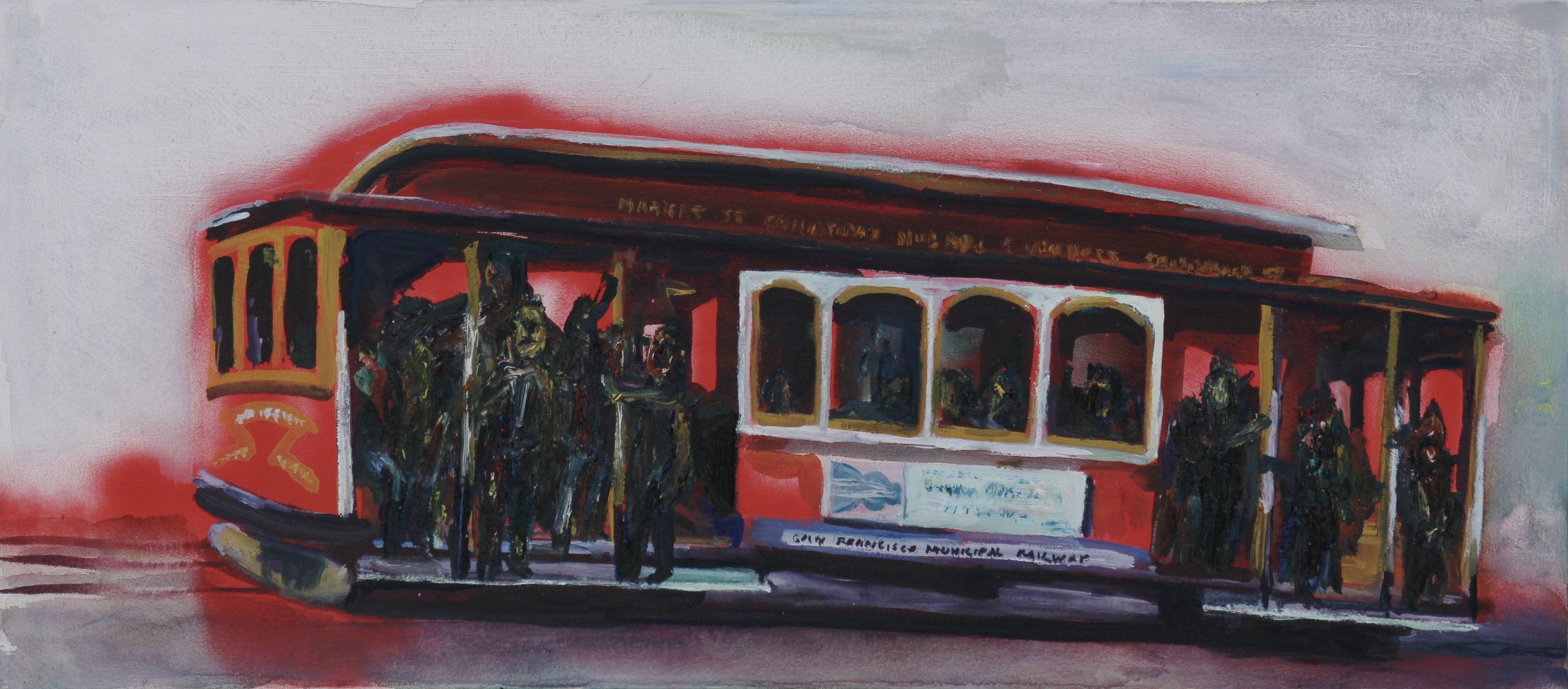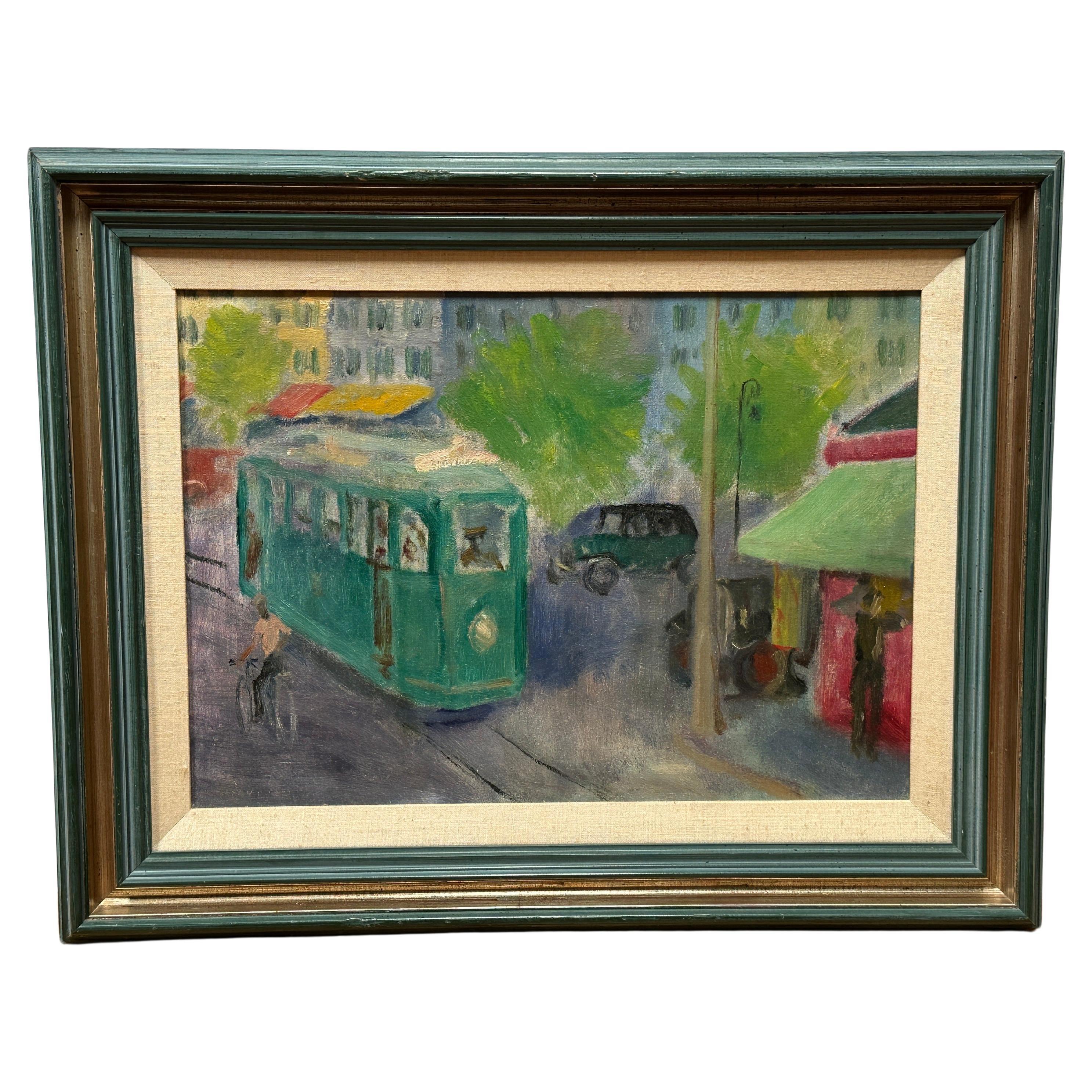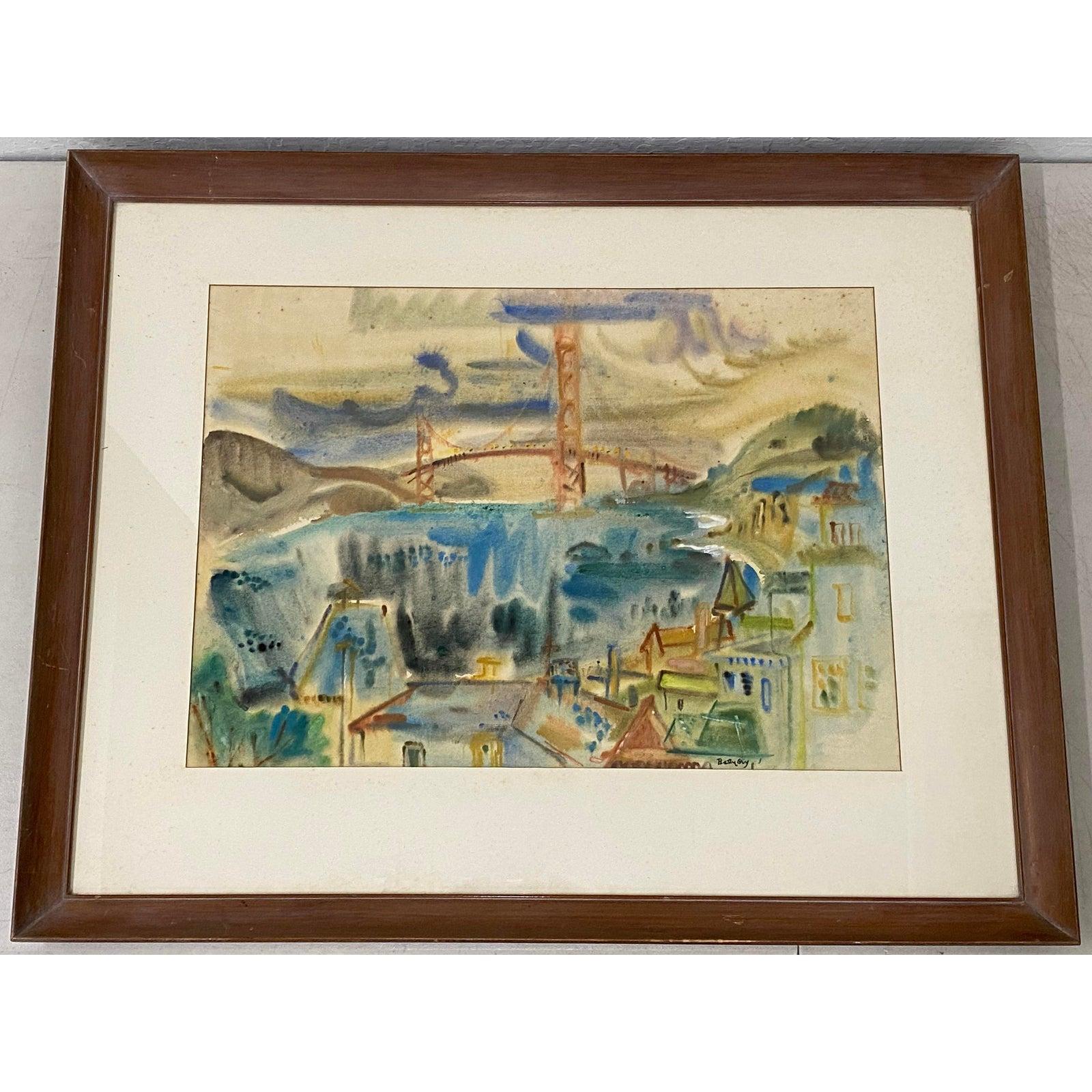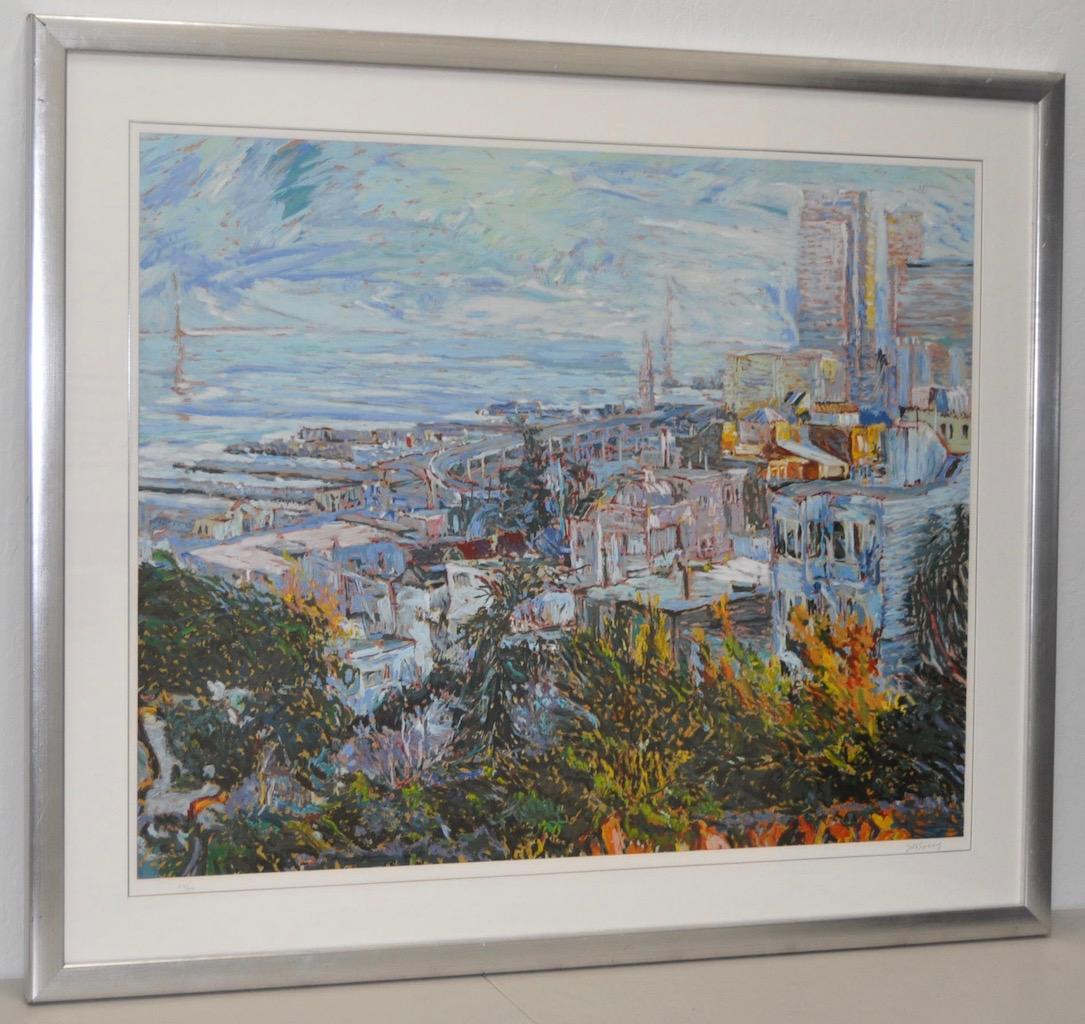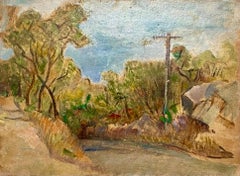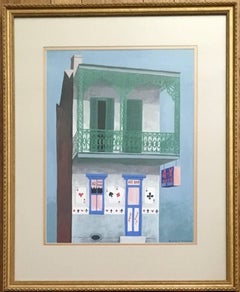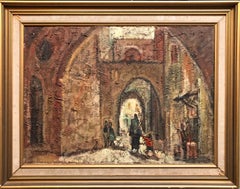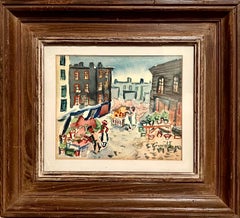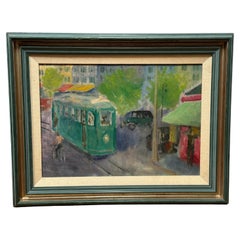Items Similar to San Francisco Cable Car WPA Artist Adolf Dehn Modernist Art Gouache Oil Painting
Want more images or videos?
Request additional images or videos from the seller
1 of 14
Adolf DehnSan Francisco Cable Car WPA Artist Adolf Dehn Modernist Art Gouache Oil Paintingc.1930-1940
c.1930-1940
$3,600
£2,720.40
€3,141.40
CA$5,030.46
A$5,581.72
CHF 2,923.82
MX$68,446.81
NOK 37,190.02
SEK 35,105.79
DKK 23,427.36
Shipping
Retrieving quote...The 1stDibs Promise:
Authenticity Guarantee,
Money-Back Guarantee,
24-Hour Cancellation
About the Item
ADOLF ARTHUR DEHN (American, 1895-1969)
San Francisco Bay Area street scene, with Trolley, Streetcar, Cable Car with bay and Alcatraz Island in background.
Hand signed LRC.
Sight 19" x 15", overall 23" x 19".
Adolf Dehn (November 22, 1895 – May 19, 1968) was an American artist known mainly as a lithographer. Throughout his artistic career, he participated in and helped define some important movements in American art, including regionalism, social realism, and caricature. A two-time recipient of the Guggenheim Fellowship, he was known for both his technical skills and his high-spirited, droll depictions of human foibles.
Adolph Dehn was born in 1895 in Waterville, Minnesota. He began creating artwork at the age of six, and by the time of his death had created nearly 650 images.
Dehn went to the Minneapolis School of Art (known today as the Minneapolis College of Art and Design), where he met and became a close friend of Wanda Gag. In 1917 he and Gág were two of only a dozen students in the country to earn a scholarship to the Art Students League of New York. He was drafted to serve in World War I in 1918, but declared himself a conscientious objector and spent four months in a guardhouse detention camp in Spartanburg, SC and then worked for eight months as a painting teacher at an arm rehabilitation hospital in Asheville, NC. Later, Dehn returned to the Art Students League for another year of study and created his first lithograph, The Harvest.
In 1921 Dehn's lithographs were featured in his first exhibition at Weyhe Gallery in New York City. From 1920 to 1921 in Manhattan, he was connected to New York's politically left-leaning activists. In 1921, he went to Europe. In Paris and Vienna he belonged to a group of expatriate intellectuals and artists, including Andrée Ruellan, Gertrude Stein, and ee cummings. Dehn found living in Europe cheap and was able to embark on artist adventures of what some consider the "glory years" of the 20s. He was influenced in this period by European artists such as Jules Pascin and George Grosz. About his time in Europe, he said, "Life in Paris is simply glorious." He supported himself through his time in Europe by providing light-hearted cartoons and scenic European landscapes to editors back in the U.S. A number of the caricatures he drew depicting the Roaring 20s, burlesque, opera houses, and the café scene appeared in such magazines as Vanity Fair. The fame that Dehn achieved during his time in Europe, his illustrations appearing in many leftist publications such as The Liberator, The New Masses, and The Dial, was noted by hometown paper The Minneapolis Journal in 1925. Throughout his time in Europe, Dehn was in contact with many other notable intellectuals and artists of the time, including Josephine Baker, Kurt Weill, and Leo Stein.
In 1929 Dehn returned to New York City with his wife. In New York, he began to focus his art on depicting scenes of Manhattan, showcasing the skyline and views of the city from the Staten Island Ferry. As the Great Depression had taken hold of the country, Dehn and his wife were desperately poor, and their financial difficulties contributed to their ultimate divorce. In the 1930s, his work began to appear in magazines such as The New Yorker and Vogue. During his period as a lithographer, his striking images of New York, including Central Park, captured the essence of the Roaring 20s and the 1930s Depression.
He summered on Martha's Vineyard from 1933 to 1936, often in the company of Thomas Hart Benton, Jackson Pollock, Georges Schreiber, and others in the vicinity of Gay Head and Menemsha, and joined by his girlfriend at the time, Eileen Lake. In the early 1930s, Dehn established The Adolf Dehn Print Club and became a founding member of the Associated American Artists. Prints magazine selected Dehn as one of the 10 best printmakers in the United States in 1936. Dehn earned a Guggenheim Fellowship in 1939, which allowed him to travel to the western United States and Mexico. In the early 40s, he worked as an instructor of etching and lithography at the Colorado Springs Fine Arts Center and received a citation from the U.S. treasury department for "Distinguished Service Rendered in Behalf of War Savings Program."
Dehn worked for the Works Progress Administration, WPA in this period. Many well known Jewish and Immigrant artists worked for the Federal Art Project (the New Deal) commonly referred to as the WPA, including Berenice Abbott, William Baziotes, Aaron Bohrod, Ilya Bolotowsky, Stuart Davis, Adolf Dehn, Ben Shahn, Willem de Kooning, William Gropper, Arshile Gorky, Jan Matulka, Irene Rice Pereira, Louis Schanker and Jean Xceron. Dehn started executing watercolor paintings in late 1936, admitting he had "been afraid of color" in the first decades of his career. He was a part of the American Scene movement, led by figures such as Grant Wood and Thomas Hart Benton and was getting national attention. Dehn's work fit squarely into this new artistic tendency. He rose to the top tier of American watercolorists in short order, seen in a feature article on his landscape watercolors in Life magazine (August, 1941) and a traveling show organized by the Museum of Modern Art, "Four American Water Colorists" (1943–44) in which eleven Dehn watercolors were joined with the works of Winslow Homer, John Singer Sargent, and Charles Burchfield. Watercolor painting and casein painting represented signature second and third arms of Dehn's artistic output for the rest of his career.
In 1947 he joined the Society of American Graphic Artists, exhibiting his lithograph, Lake in Central Park, in the 32nd Annual Exhibition. As well as visiting and painting Key West and the southwestern region of the United States, he went to Venezuela, Cuba, Haiti, Afghanistan and other areas of the world. The wide range of subject matter found in his prints, drawings, and paintings reflects his travels. He was awarded a second Guggenheim Fellowship in 1951. In 1961, Dehn was elected as a full academician to the National Academy of Design, and in 1965 he was elected as a member of the National Institute of Arts and Letters. He visited Paris for the last time in 1967, where he worked at the Atelier Desjobert. Dehn died in New York City on May 19, 1968. He is remembered as a prolific artist of great range. His works are held in over 100 museums (including the National Gallery of Art, National Portrait Gallery, Metropolitan Museum, Museum of Modern Art, and Whitney Museum of American Art); over 25 museums hold extensive collections of his output.
Selection of Museum Collections
Albertina Museum Vienna, Austria
Albright-Knox Art Gallery Buffalo, NY
Art Institute of Chicago Chicago, IL
Audubon House and Tropical Gardens Key West, FL
Boca Raton Museum of Art Boca Raton, FL
British Museum London, UK
Brooklyn Museum Brooklyn, NY
Buffalo Bill Center of the West Cody, WY
The Butler Institute of American Art Youngstown, OH
Carnegie Museum of Art Pittsburgh, PA
Detroit Institute of Arts Detroit, MI
Smithsonian Hirshhorn Museum and Sculpture Garden Washington, DC
The Metropolitan Museum of Art New York, NY
Mitchell Wolfson Collection Miami Beach, FL
Museum of Modern Art New York, NY
National Gallery of Art Washington, DC
Pennsylvania Academy of the Fine Arts Philadelphia, PA
Philadelphia Museum of Art Philadelphia, PA
San Francisco Museum of Modern Art San Francisco, CA
São Paulo Museum of Art São Paulo, Brazil
Smithsonian National Portrait Gallery Washington, DC
Wadsworth Atheneum Hartford, CT
Walker Art Center Minneapolis, MN
Whitney Museum of American Art New York, NY
Woodstock Artists Association and Museum Woodstock, NY
Yale University Art Gallery New Haven, CT
Exhibition history
Select Adolf Dehn exhibitions,
Engaging the Far West: Adolf Dehn's Colorado and Peter Hurd's New Mexico D. Wigmore Gallery, New York, NY
Artist Book Foundation (at MASS MoCA), North Adams, MA
Adolf Dehn: Love, Labour, Leisure Mercy Gallery, Richmond Art Center
Adolf Dehn: A Retrospective of Prints Associated American Artists Galleries
1979 Adolf Dehn The Full Range Hirschl & Adler Galleries, New York, NY
1970-1971 Represented by Kennedy Galleries, New York, NY
1957 New Painting Milch Gallery, New York, NY March
1956 New Paintings Associated American Artists Galleries, New York, NY
1951 Haitian World Associated American Artists Galleries, New York, NY
1948 Exhibition Whitney Museum of American Art, New York, NY
1947 Lithographs by Adolf Dehn Smithsonian Institution, Washington, DC
1945 Solo exhibition at national museum, Caracas, Venezuela
1944 Four American Watercolorists Museum of Modern Art, New York, NY
Naval Aviation Metropolitan Museum of Art, New York, NY January
1943 International Watercolor Exhibit, The Art Institute of Chicago, Chicago, IL
1942 Exhibition Whitney Museum of American Art, New York, NY
1940 Watercolors by Adolf Dehn Weyhe Gallery, New York, NY
1931 Ink Drawings by Adolf Dehn Weyhe Gallery, New York, NY
1928 Solo gallery exhibition Paris, France
1923 Group exhibition Wurthle and Sohn Gallery, Vienna, Austria
1915 First museum show (drawings) Minneapolis Institute of Arts
- Creator:Adolf Dehn (1895 - 1968, American)
- Creation Year:c.1930-1940
- Dimensions:Height: 23 in (58.42 cm)Width: 19 in (48.26 cm)
- Medium:
- Movement & Style:
- Period:
- Condition:Frame with age commensurate wear. Small area of minor chipping/cracking to paint on surface. Please see photos.
- Gallery Location:Surfside, FL
- Reference Number:1stDibs: LU38212326012
About the Seller
4.9
Platinum Seller
Premium sellers with a 4.7+ rating and 24-hour response times
Established in 1995
1stDibs seller since 2014
1,780 sales on 1stDibs
Typical response time: <1 hour
- ShippingRetrieving quote...Shipping from: Surfside, FL
- Return Policy
Authenticity Guarantee
In the unlikely event there’s an issue with an item’s authenticity, contact us within 1 year for a full refund. DetailsMoney-Back Guarantee
If your item is not as described, is damaged in transit, or does not arrive, contact us within 7 days for a full refund. Details24-Hour Cancellation
You have a 24-hour grace period in which to reconsider your purchase, with no questions asked.Vetted Professional Sellers
Our world-class sellers must adhere to strict standards for service and quality, maintaining the integrity of our listings.Price-Match Guarantee
If you find that a seller listed the same item for a lower price elsewhere, we’ll match it.Trusted Global Delivery
Our best-in-class carrier network provides specialized shipping options worldwide, including custom delivery.More From This Seller
View AllSimka Simkhovitch WPA Artist Oil Painting Gouache American Modernist Powerline
By Simka Simkhovitch
Located in Surfside, FL
Simka Simkhovitch (Russian/American 1893 - 1949)
This came with a small grouping from the artist's family, some were hand signed some were not.
These were studies for larger paintings.
Simka Simkhovitch (Симха Файбусович Симхович) (aka Simka Faibusovich Simkhovich) (Novozybkov, Russia May 21, 1885 O.S./June 2, 1885 N.S.—Greenwich, Connecticut February 25, 1949) was a Ukrainian-Russian Jewish artist and immigrant to the United States. He painted theater scenery in his early career and then had several showings in galleries in New York City. Winning Works Progress Administration (WPA) commissions in the 1930s, he completed murals for the post offices in Jackson, Mississippi and Beaufort, North Carolina. His works are in the permanent collections of the Dallas Museum of Art, the National Museum of American Art and the Whitney Museum of American Art. Born outside Kyiv (Petrograd Ukraine) into a Jewish family who owned a small department store. During a severe case of measles when he was seven, Simcha Simchovitch sketched the views outside his window and decided to become an artist, over his father's objections. Beginning in 1905, he studied at the Grekov Odessa Art School and upon completion of his studies in 1911 received a recommendation to be admitted to the Imperial Academy of Arts. Though he enrolled to begin classes in architecture, painting, and sculpture at the Imperial Academy, he was dropped from the school roster in December because of the quota on the number of Jewish students and drafted into the army. Simchovitch served as a private in the 175th Infantry Regiment Baturyn [ru] until his demobilization in 1912. Re-enrolling in the Imperial Academy, he audited classes.
Simka Simkhovitch exhibited paintings and sculptures in 1918 as part of an exhibition of Jewish artists and in 1919 placed 1st in the competition "The Great Russian Revolution" with a painting called "Russian Revolution" which was hung in the State Museum of Revolution. In 1922, Simkha Simkhovitch exhibited at the International Book Fair in Florence (Italian: Fiera Internazionale del Libro di Firenze). In 1924, Simkhovitch came to the United States to make illustrations for Soviet textbooks and decided to immigrate instead. Initially he supported himself by doing commercial art and a few portrait commissions. In 1927, he was hired to paint a screen for a scene in the play "The Command to Love" by Fritz Gottwald and Rudolph Lothar which was playing at the Longacre Theatre on Broadway. Art dealers began clamoring for the screen and Simkhovitch began a career as a screen painter for the theater. Catching the attention of the screenwriter, Ernest Pascal, he worked as an illustrator for Pascal, who then introduced him to gallery owner, Marie Sterner. Simkhovitch's works appeared at the Marie Sterner Gallery beginning with a 1927 exhibit and were repeated the following year. Simkhovitch had an exhibit in 1929 at Sterner's on circus paintings. In 1931, he held a showing of works at the Helen Hackett Gallery, in New York City and later that same year he was one of the featured artists of a special exhibit in San Francisco at the California Palace of the Legion of Honor in Lincoln Park. The exhibit was coordinated by Marie Sterner and included four watercolors, including one titled "Nudes". He is of the generation of Russian Soviet artists such as Isaac Pailes, Serge Charchoune, Marc Chagall, Chana Orloff, Isaac Ilyich Levitan, and Ossip Zadkine.
In 1936, Simkhovitch was selected to complete the mural for the WPA Post office project in Jackson, Mississippi. The mural was hung in the post office and courthouse in 1938 depicted a plantation theme. Painted on the wall behind the judge’s bench, “Pursuits of Life in Mississippi”, a depiction of black workers engaged in manual labor amid scenes of white professionals and socialites, was eventually covered over in later years during renovations due to its stereotypical African American imagery. Simka painted what he thought was typical of Jackson. His impression of pre-civil rights Mississippi was evidently Greek Revival column houses, weeping willow trees, working class families, and the oppression of African Americans. He painted African American men picking cotton, while a white man took account of the harvest and a white judge advised a white family, calling it Pursuits of Life in Mississippi.
Though clearly endorsed by the government and initially generally well-received, the mural soon raised concerns with locals as the climate toward racial segregation began to change. The main concern was whether depictions that show African Americans in subjugated societal roles should be featured in a courtroom. The following year, his painting "Holiday" won praise at an exhibition in Lincoln, Nebraska. In 1940, Simkhovitch's second WPA post office project was completed when four murals, "The Cape Lookout Lighthouse and the Orville W. Mail Boat", "The Wreck of the Crissie Wright", "Sand Ponies" and "Canada Geese" were installed in Beaufort, North Carolina. The works were commissioned in 1938 and did not generate the controversy that the Jackson mural had. The main mural is "The Wreck of the Crissie Wright" and depicts a shipwreck which had occurred in Beaufort in 1866. "The Cape Lookout Lighthouse and the Orville W. Mail Boat" depicted the lighthouse built in 1859 and the mail boat that was running mail during the time which Simkhovitch was there. The boat ran mail for the area until 1957. "Sand Ponies" shows the wild horses common to the North Carolina barrier islands and "Canada Geese" showed the importance of hunting and fishing in the area. All four murals were restored in the 1990s by Elisabeth Speight, daughter of two other WPA muralists, Francis Speight...
Category
1930s American Modern Landscape Paintings
Materials
Oil, Board, Gouache
Ace Bar, Gouache American Scene. Witold Gordon
By Witold Gordon
Located in Surfside, FL
Witold Gordon
(1885 – 1968)
The painter and muralist, Witold Gordon, was born in Warsaw, Poland. He moved to Paris as a young man and studied there at the Ecole de Beaux Arts before moving to the United States. He had a distinguished career including the production of two major murals at Radio City Music Hall in 1932. These were coordinated by the prominent American designer, Donald Deskey, and included Witold Gordon among the periodʼs foremost avant-garde artists along with Stuart Davis and William Zorach, among others.
Gordon was later commissioned to conceive a 6000 square foot mural for a building at the New York Worldʼs Fair in 1939 and this amazing feat is captured in postcards from the fair as well as commemorative film footage and color photographs. His modernist aesthetic is evident in his illustrations for The Travels of Marco Polo and his fine poster for the 1932 Olympics...
Category
20th Century Modern Landscape Paintings
Materials
Gouache
Jerusalem Old City Cityscape Israeli Modernist Oil Painting Signed in Hebrew
Located in Surfside, FL
Signed Nathanson. Could be the famous artist Avraham Naton (Natanson) I am not certain. it is a very lovely Modernist Israeli landscape.
Avraham Naton (Natanson), Israeli, born in Bessarabia, 1906-1959. Avraham Naton was born in Rani, Bessarabia to a large secular family. In 1935, after Art studies in Romania, he immigrated to the Land of Israel and settled, first, in Givat Haim and later in Ramat Gan. From the 1940s he worked as an Art teacher in Ramat Gan and Givataim. In 1948 he worked as an illustrator at BaMahane Newspaper. He was one of the Founders of New Horizon Group. Between 1952-1959 he was a member of the Milo Club and served as the club secretary.
Education
1930-33 Art Academy, Bucharest, Romania
Teaching
1940's Ramat Gan and Givataim
Awards And Prizes
Jerusalem Prize for Painting and Sculpture
1942 Dizengoff Prize
1953 Milo Club Prize
New Horizons, The Ofakim Hadashim art movement began with a group of artists who mounted an exhibition in Tel Aviv's Habima national theater in December 1942, under the name "The Group of Eight". The group evolved into a coherent artistic movement only after the founding of the state of Israel in 1948. Members of the school included Arie Aroch, Zvi Meirovitch, Avraham Naton (Natanson), Avigdor Stematsky and Yehezkel Streichman. The work of sculptor Dov Feigin also appeared in the catalog of the 1942 exhibition, though it was not displayed. In February 1947 five of the original members of the group joined Joseph Zaritsky...
Category
1950s Modern Landscape Paintings
Materials
Canvas, Oil
1940's American WPA Modernist New York City Watercolor Painting Tenement Market
By Samuel Grunvald
Located in Surfside, FL
The Market, (fauvist painting of NYC scene) 1940's.
image is 10X 11.5 inches. Hand signed lower right
Lower East Side Tenements Pushcart Market
Samuel Grunvald was a Hungarian born American WPA artist known for abstract, landscape and seascape paintings.
Arrived in the USA from Hungary in 1921 and settled in New York City where he studied at the Art Students League. Grunvald worked for the Federal Art Project, taught at Colony House in NYC. Member: Art Guild, Watercolor Society, New York Watercolor Club. exhibited at Montross Gallery, NYC, World House Galleries, NYC, Leonard Hutton Gallery, NYC, Associated American Artists Gallery and the A.C.A. Gallery. Gunvald's work spanned many modern American movements from the WPA to Abstract Expressionist painting. He was a member of the American Watercolor Society and the Brooklyn Society of Artists. He exhibited with both of these organizations and at the Brooklyn Museum of Art. He was involved the the WPA being a Federal Arts Project artist. A number of prominent Jewish artists participated in this New Deal program among them Ben Shahn, Joseph Solman, William Gropper, Philip Guston Adolph Gottlieb, Mark Rothko, Milton Avery, Ben Shahn, the Soyers (Isaac, Moses, and Raphael), and many others
Grunwald exhibited alongside other popular artists such as Paul Klee, Jean Arp, Max Ernst and Charles Burchfield. He also taught and lectured on art and easel painting, Federal Art Project, NYC. His work is included in the collections of the Museum of Modern Art and The Jewish Museum, New York. Americana.
Select Exhibitions
A.C.A. Gallery
Associated American Artists Gallery, 1936-1955
American Watercolor Society, 1932-1942
New York Watercolor Club, 1935-1937
Humanist Art...
Category
1940s Modern Figurative Drawings and Watercolors
Materials
Watercolor
Quai De La Tournelle, Paris Street Scene Oil Painting, American Deaf Modernist
By Robert Freiman
Located in Surfside, FL
Paris street scene oil painting in original vintage hand carved frame, showing some wear. Signed l.r. and dated 1953. Inscribed on reverse with title.
28.50 in. by 33.50 in. include frame. Unframed 19.75 in. by 24 in.
Robert Freiman, deaf from birth, was born in March 1917 in New York City. He attended an oral program near his home and later transferred to the Lexington School for the Deaf when he was six. Early in his childhood, his love for drawing, painting and studying became apparent, and as an adult, he continued his studies in New York at the National Academy of Design, Pratt Institute, the Art Students League and the Parsons School of Design. In Paris, France he studied at the Ecole des Beaux Arts. Bob Freiman was especially focused on painting portraits and figures in motion in various mediums, especially the mixed-media combination of watercolor, acrylic and pen. Among his subjects were acrobats, ballet dancers, cyclists and other athletes. He as well focused on abstracts for a time, discovering new media in his works with quick brushwork and expressive movements.
In the latter part of his career, his style became abstract and surreal with images of metaphysical landscapes with architectural elements such as arches, towers, pyramids and castles floating in the air. The famed art critic Pierre Rouve wrote: “It is therefore refreshing to see them revitalized by the colourist wealth and virile handwriting of Robert Freiman, probably the best American water-colorist since John Marin. He worked in Provincetown and Nantucket and regularly exhibited there. He showed at Doll & Richards gallery of Boston alongside John Chetcuti, Lloyd Goodrich, Tod Lindenmuth, William Meyerowitz, Dwight Shepler, Elizabeth O'Neill Verner, Stanley Woodward, Andrew Wyeth, and others. His work bears the influence of the mid century school of Paris in particular Jean Carzou. He was a regular exhibitor at the Sidewalk Art...
Category
Mid-20th Century Expressionist Landscape Paintings
Materials
Oil
Large Polish French Paris Scene Mid Century Modernist Oil Painting Moulin Rouge
By Abram Krol
Located in Surfside, FL
Wonderful scene of the Moulin Rouge cabaret nightclub at Place Pigalle in Paris. Painted in wonderful moody blue and red colors.
Size includes frame.
Abram Abraham Krol was born Jan...
Category
1950s Modern Landscape Paintings
Materials
Canvas, Oil
You May Also Like
San Fransisco Cable Car, Painting, Acrylic on Canvas
By John Kilduff
Located in Yardley, PA
Painted this in the studio, based on a photo I took of a Cable Car in San Francisco. This is part of a new series of paintings where I spray paint the outline and than use watered-do...
Category
2010s Pop Art Paintings
Materials
Acrylic
Tram in the Streets of San Francisco Oil Painting on Canvas
Located in Pasadena, CA
Captured on canvas with delicate impressionist strokes, this oil painting transports us to the bustling streets of San Francisco. On the left, a vintage blue-green tram glides toward...
Category
Mid-20th Century North American Mid-Century Modern Paintings
Materials
Canvas
$650 Sale Price
31% Off
Vintage Mini Mid-Century Modern Street Scene Framed Oil Painting - The Tram
Located in Bristol, GB
THE TRAM
Size: 38 x 33 cm (including frame)
Oil on Canvas
A small yet very striking modernist street scene composition, executed in oil onto canvas.
The painting depicts a bustling...
Category
Mid-20th Century Modern Landscape Paintings
Materials
Canvas, Oil
Pair of Signed Benjamin Jorj Harris Airbrush San Francisco Cable Car Artworks
Located in Pasadena, TX
Artist Benjamin Jorj Harris
Birth: 1904
Death: 1957
Lived/Active New York
Often known for Illustration-watercolor
Features:
1940s da...
Category
Mid-20th Century American Mid-Century Modern Paintings
Materials
Paper
Betty Guy San Francisco Skyline Watercolor c.1950
By Betty Guy
Located in San Francisco, CA
Betty Guy San Francisco Skyline Watercolor c.1950
Dimensions 25" wide x 18" high.
Frame 25.5" wide x 28.5" high.
Signed by the artist.
Lightly distressed...
Category
Mid-20th Century Impressionist Landscape Drawings and Watercolors
Materials
Paper, Watercolor
San Francisco from Telegraph Hill Serigraph by Marco Sassone 20th c.
By Marco Sassone
Located in San Francisco, CA
San Francisco from Telegraph Hill Serigraph by Marco Sassone 20th c.
Limited edition pencil signed serigraph by listed California / Canadian artist Marco Sassone. San Francisco from...
Category
Late 20th Century Impressionist Landscape Prints
Materials
Screen
More Ways To Browse
San Francisco Lithograph
40s French Art
San Francisco Etching
1920 Modernist Painting
Vintage French Cars
Southwestern Paintings
Vintage Car Painting
Tropical Island Art
Oil Painting Of George Washington
New Masses
Dior Car
Vintage Aviation Art
Gay Vintage Art
American Southwestern Artists
Vintage San Francisco Street Signs
Oil Painting Richmond
British Cars
Manhattan Skyline Art
